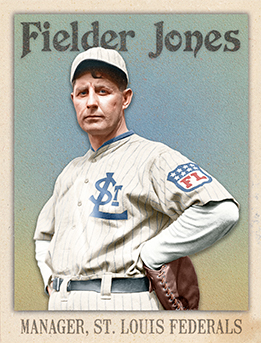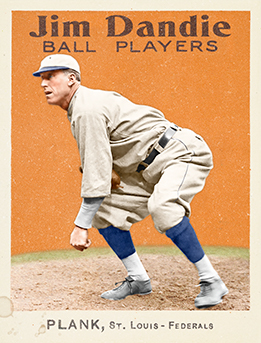- Series: Jim Dandie Feds
- City: St. Louis
- Team: Terriers
- League: Federal League
- Hall: National Baseball Hall of Fame
Edward Stewart Plank (1875-1926) hurled more shutouts and complete games than any other lefthander in his 17-season career. He ranks behind only Warren Spahn and Steve Carlton among southpaws in wins. Signed by Connie Mack straight out of college, Plank never played a day in the minors. Playing in 4 Series for Philadelphia, Plank had an ERA of 1.32 but got no run support, going 2-5 but finishing all six of his starts.
- His 326 wins ranks 13th on the all time list. He had eight 20-win seasons
- At the end of his career, played for St. Louis in the Federal League’s final year in 1915 and then with the Browns for two more
- Elected to Hall of Fame: 1946

- Series: Diamond Heads '15
- City: St. Louis
- Team: Terriers
- League: Federal League
Fielder Allison Jones (1871-1934) made his name in baseball's history books by eking just enough results from minimal production to win the White Sox their first Series title in 1906. That club has forever been known as the “Hitless Wonders,” a squad of light-hitting scrappers who, under Jones' able direction, were able to best the powerful Cubs. The '06 Series was noteworthy as the first cross-town matchup and the only one to pair the Chicago franchises. It was also one of the greatest upsets, with the Cubs' bats held in check by Ed Walsh and other Sox hurlers. In taking the final two contests, Jones' crew stepped out of character and rapped 26 hits. Overall, though, his boys lived up to their “hitless” reputation, managing only a .198 average for the series. Jones was one of the most adept managers of his era in teaching “inside baseball” or “small-ball” whereby his charges frequently plated runs without the benefit of hits in the inning. Jones was a blue-blood, tracing his heritage to Scotland's Robert Bruce on one side and a Mayflower landing on the other. He had university training that perhaps predicted the cerebral approach Fielder always brought to the game. He had come out of rural Pennsylvania to play for Brooklyn where he helped the team to pennants in 1899 and 1900. Moving to Chicago only continued his winning ways, gaining another gonfalon in 1901, the new American League entry's first. As a player, Fielder had made a fine record, leading the Superbas in 1900 and hitting .285 overall.
- Jones moved from Chicago to St Louis when the Federal League and the Terriers beckoned him back to the majors in 1914 and he remained with the Browns through the 1918 season
- Though the White Sox were a poor hitting team in '06, they had come a long way under Jones' leadership. A writer of the day lauded him as having introduced “speed, psychology and daring into the game.”

- Series: Beginnings: 1880's
- City: St. Louis
- Team: Whites (WA)
- League: Western Association
Henry Fred Hines (1867-1928) was a fireplug of an outfielder. While his major league experience was ever so brief - two games with the Brooklyn Bridegrooms in 1895 - Hines enjoyed a long career in professional baseball. He began as a teenager in 1887 with the Milwaukee Cream Cities, getting into a mere nine games, but that humble beginning launched him into a 19-season career that didn’t end until 1910 when Hunkey played for and managed the Joliet Jolly-ites/Sterling Infants of the Northern Association. By the time Hunkey became an "Infant," he was 42 years old. The available data show that Hines’ career batting average was .250, precisely what he achieved in those two games in Brooklyn where he got two hits and walked twice in two games. The Illinois native spent most of his minor league time in the greater midwest, but he did venture as far west as the Bay Area’s Oakland Oaks in 1891 and ‘93. He played two seasons for the Detroit Tigers when they were in the Western League, 1900-01. In 1906 Hines was in the deep south playing for the Baton Rouge Cajuns, evidence that baseball afforded the sturdy Hunkey a tour of much of the continent.
- Hines’ best year at the plate was a startling .427 for the Minneapolis Minnies in 1894. This wasn’t a fluke. Hunkey had 586 at bats that career-year when he also clubbed 34 home runs. He never hit more than six in any other season of his long career

- Series: Jim Dandie Feds
- City: St. Louis
- Team: Terriers
- League: Federal League
John Thomas Tobin (1892-1969) built a fine major league career in the outfield for four teams, primarily in his hometown of St. Louis with the Federal League's Terriers in that organization's two years competing with the AL and NL, 1914-15; then staying on with the Browns for nine campaigns. “Johnny” did himself proud with the Browns, compiling a .318 average. Over his tenure in the big leagues, his average was an excellent .309. Tobin's introduction to the big leagues came via his play for his employer, Bell Telephone. He was literally recruited by the Terriers from atop a pole. He quickly established himself in St. Louis as a popular guy, both with fans and writers. Johnny led his team of MLB castoffs from last in '14 to within an eyelash of the Federal League pennant in '15, earning him a spot on the Browns. Business Manager Branch Rickey thought Tobin needed some seasoning and shipped him to the Salt Lake City Bees for most of 1917, a move that bore the mark of Rickey's genius as Tobin tore up the Coast League, leading the circuit with 265 hits. He would go on to earn the plaudits of no less than teammate George Sisler who termed him “One of the best leadoff men I ever saw” and “the best drag-bunter anyone ever saw.” The crafty speedster began piling up great seasons in St. Louis. He hit .322 in '22 when the club fell just shy of the Yankees, the only team they couldn't beat. Eventually Tobin's speed faded a bit and he was traded to the Senators in 1926 where he played very little before moving on that season to the Red Sox. His finale in '27 was a fitting resurgence by a great hitter as Tobin hit .310 in 111 games.
- Walter Johnson was another fan: “Tobin is a batter of the old school, not unlike Willie Keeler in many respects. I am glad there are not more like him.”
- Johnny became a fixture in his hometown's baseball circles, coaching youth and semi-pro leagues. In 1958 the Baseball Writers Association of America named him to the St. Louis “All-Time All-Star” squad along with such luminaries as Musial, Sisler, Frisch, Hornsby and Dizzy Dean

- Series: Jim Dandie Feds
- City: St. Louis
- Team: Terriers
- League: Federal League
Charles Albert Deal (1891-1979) like many of his peers in the early decades of baseball wanted to be fairly compensated for his talents, a concept alien to most of the owners of his day. Not even a spot on the Miracle Braves of 1914 could hold Deal's loyalty when the Federal League offered a chance at better pay. Charlie had played for Detroit in 1912-13 before joining Boston's club during the 1913 season. He was a decent third baseman who must have impressed his new team when he hit .306 late in '12. Unfortunately, although the 1914 Braves had a year for the ages, Charlie hit a mere .210 and saw greener pastures with the St. Louis Terriers in the Federal League's second and final season in '15. The move proved extremely lucrative for Deal. His salary ballooned from $2400 to $4500 plus a $3500 bonus. This may have been emblematic of the financial turmoil the Federals introduced and which led to the demise of such a profligate operation - in the minds of the establishment of the day. After the Terriers folded, Charlie played briefly for the Browns but found a home with the Cubs in 1916. In his tenure in the Windy City, interrupted by wartime obligations, Deal established himself as one of the best third basemen of the day. He never was able to hit much above his .250 norm but stayed with the Cubs through the 1921 season on the strength of his fielding prowess.
- Deal still had a taste for the game after ending his time in the big leagues. He went west and played for the Los Angeles Angels for two years and even played for the Vernon Tigers in 1924 in the industrial heart of South LA.
- Charlie moved up to Portland, still in the PCL, in '25 and wrapped up his professional career with the Southern Association's New Orleans Pelicans in 1926




